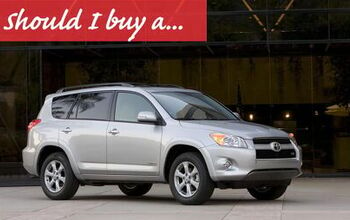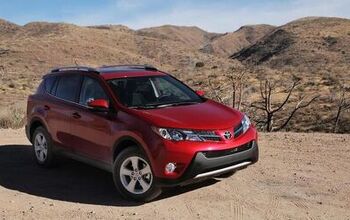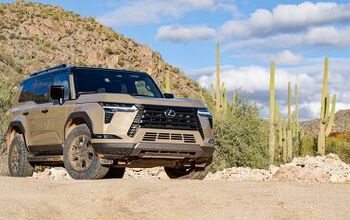2011 Toyota RAV4 Review
It was one of the very first crossovers on sale in the U.S. and over the last fifteen years, Toyota’s RAV4 has carved out a well-deserved reputation as an affordable and reliable small CUV that’s proved especially popular with young adults and families. However, during that time the segment it helped create has morphed into one of the most hotly contested in the automobile business, giving buyers a number of worthy alternatives to Toyota’s original pioneer. That said, does the RAV still have what it takes to remain a top contender?
FAST FACTS
| 1. Two engines are offered, a 179-hp 4-cylinder and a 269-hp V6. |
| 2. Fuel economy has been improved and rates from 22/28-mpg (city/hwy) for front-drive 4-cyl models to 19/26-mpg for V6 4WD models. |
| 3. Base, Sport and Limited models are available with either the 4-cylinder or V6 and either FWD or 4WD. |
| 4. New for 2011 is an Upgrade Value Package for Base models that includes a six-CD audio system with XM Radio, steering wheel audio controls, 17-inch wheels, daytime running lights, a moonroof and higher-grade interior fabric. |
Although Toyota’s reputation in quality and reliability has taken a battering over the last two years as a result of numerous, highly publicized recalls, essentially all of its product offerings in North America have a stellar reputation for quality, durability and reliability. And as a result still appeal to a wide and captive audience. The RAV4 is no exception.
Extensively redesigned for the 2006 model year, it adopted a more grown up look and a 6.7-inch wheelbase stretch, yielding a more than 20 percent increase in passenger and cargo space. A further modernization for 2009 saw the adoption of a larger, more powerful 179-hp 2.5-liter four-cylinder engine (replacing a 166-hp 2.4), equipment shuffles and a mild facelift. For 2011, the little CUV mostly marks time and continues in Base (starting at $21,925), Sport ($23,625) and Limited ($24,915) trim levels, with a choice of front or 4WD drivelines and four-cylinder or V6 engines.
HOME MARKET CENTRIC
For those used to any Toyota product of the last decade, the current RAV has an air of familiarity. It’s decently put together with good fit and finish, fairly precise panel fit and the paint largely devoid of orange peel – something at still afflicts some rival vehicles.
RAV4 Limited models boast a unique front fascia and deeper grille, which lends a more distinctive and somewhat aggressive look. The doors close with a decent sounding "thwack" but what we can’t understand is why the rear one still hinges open to the right. It’s fine if you live in somewhere like Australia, Japan or the UK, but over here it’s just plain awkward. There were a couple of times when, parked on a city street, we had to venture out into traffic and open the thing – watching out in case we were hit by the mirrors of a passing vehicle. Considering that Toyota markets this vehicle towards young families, it’s a potential safety issue, especially when more than 74 percent of the world’s motoring is done on the right side of the road.
TOP QUALITY INTERIOR BUT STANDARD EQUIPMENT LACKING
In terms of interior fit, comfort and practicality, the RAV4 scores quite highly. It’s more spacious than the current Honda CR-V and fit and finish are still above much of the competition, including the likes of the Chevy Equinox and GMC Terrain. Thanks to the Optitron gauges, the dash is legible and easy to read (both day and night), the control stalks solid and easy to operate, plus all the center stack controls are large, functional and fall readily to hand.
The front seats are typical Toyota, fairly wide and comfortable with adequate fore/aft and lumbar adjustment. However, compared with some rivals, the cabin seems a bit austere. Base and Sport trim RAVs come with a rudimentary sound system and lack features such as a leather-wrapped steering wheel, standard cargo cover, second row HVAC and satellite radio – items that now come standard on many rivals. You can get these features on the RAV, but you have to step up to the Limited (which adds $1,300) or new for 2011 is an Upgrade Value Package that includes a six-CD audio system with XM Radio, steering wheel audio controls, 17-inch wheels, daytime running lights, a moonroof, that cargo cover and higher-grade interior fabric.
For second row riders, seat comfort is decent as is stretching space. Aided by a fairly square roofline, there’s more than 38-inches of head clearance for the second row and almost 39-inches of leg space, enabling two 6-foot plus adults to sit in quality comfort – there’s plenty of space for three kids. The second row seat also handily stows in a 60/40 format providing a welcomed amount of additional cargo space as well as access to the third row seat – a rarity in this segment. The latter is best reserved for a pair of tots, but again headroom is more generous than some other vehicles in the class and when not in use, the third row folds into a well in the floor, allowing for a fully flat loading area.
HOT ROD V6 BUT FUEL ECONOMY LAGGING
On the road, the RAV displays fairly pleasant driving characteristics. With the 2.5-liter four-cylinder (rated at 179 horsepower and 172 ft-lbs), acceleration is quite peppy, though the four-speed automatic (the only transmission available with it), feels reluctant to downshift at times, making steep hills or quick passing maneuvers a bit frustrating, especially when you consider that max grunt doesn’t arrive until 4000 rpm and you’ve got 3,400 lbs of weight to haul about.
The V6, by contrast, is a hot rod engine. Rated at 269 horsepower and 246 ft-lbs of torque, it turns the RAV into a sleeper – with gutsy acceleration and an accompanying soundtrack. In fact, Toyota rates the acceleration of the V6 model in the six second range! It pulls hard right through the rev range and has plenty of thrust in reserve for just about anything, and at highway speeds is decently quiet. The five-speed automatic coupled to it is much smoother in operation than the four-speeder on four-cylinder powered RAVs – under acceleration the shifts are crisp and precise, plus despite the V6 also having a fairly peaky torque curve, the five-speed slushbox is well matched to it.
A $160 tow prep package is also offered on the V6, that includes a heavy-duty cooling system, transmission cooler and alternator, enabling the RAV to tow up to 3,500 lbs, making it ideal for towing small boats or watercraft.
As for fuel economy the four-cylinder manages around 22-mpg in town, 28-mpg on the highway for front-drivers and 21/27-mpg for 4x4s. The V6 isn’t far behind at not far behind at 19/27-mpg (4×2) and 19/26-mpg (4×4).
COMFORT-ORIENTED RIDE
Aided by the fairly long wheelbase, ride quality is comfortable without being to soft and the all-independent suspension does an admirable job in soaking up rough road imperfections. Wind noise is quite noticeable however, especially around the base of windshield at speeds above 65 mph, not something one tends to expect from a Toyota.
Handling is fairly predictable, though at higher speeds through the turns or during quick lane changes, there’s noticeable body roll and front-end understeer – something we do normally expect from a Toyota. The weakest link is the tires – the 215/70/16s as fitted to base models offer merely adequate grip and under load on slippery roads, even with the active limited slip differential, traction on front-drive examples can be tricky at times.
4WD versions offer improved grip, but for maximum road contact it’s best to step up to larger wheels and tires. Toyota does offer bigger 225/65//17 tires on V6 models (a good call in view of this engine’s sprinting ability), while Sports are fitted with 235/55/18s which seem to be highly effective and do a good job in enhancing the bigger motor’s torque – whether in a straight line or through the corners.
The RAV’s priorities remain very much tarmac biased. While you can venture somewhat off the beaten path and the system is great if you live in the snowbelt, the absence of low range means that traction can be difficult and the real rough stuff is best left for other more specialized rigs.
The steering offers decent on center feel during highway driving but under sharp directional changes or fast corners feels a little spongy At slow speeds, however, it’s fairly light touch and the RAVs impressive turning circle makes city parking a doddle. Toyota offers a hill start assist and descent control feature that helps hold the vehicle on hills. It can prove most helpful in urban settings with steep grades (think San Francisco), allowing you to concentrate much more on maneuvering the RAV, especially in busy locations with pedestrians and parked cars.
THE VERDICT
Although it’s by no means the spring chicken of compact SUVs, despite its 2009 freshening, the RAV4 still manages to deliver a potent package, with good interior space and surprising performance from the V6 powertrain. The optional 3rd row is also a bonus.
While a solid package, there are two important drawbacks to the RAV, namely fuel economy and price. In this hotly contested segment there are newer rivals that offer a greater amount of standard equipment for less money.
RELATED READING
2009 Honda CR-V
2010 Chevrolet Equinox 1LT AWD Review
2010 Hyundai Tucson: First Drive
2008 Nissan Rogue SL AWD Review
2008 Ford Escape Review
2009 Volkswagen Tiguan
LOVE IT
- Acceleration (V6)
- Ride quality
- Spacious interior
- Optional 3rd row
LEAVE IT
- Acceleration (4-cylinder)
- Could use more standard equipment
- Cargo door opens the wrong way
- Options can make it pricey
- Fuel economy starting to lag behind competitors
More by Huw Evans






































Comments
Join the conversation